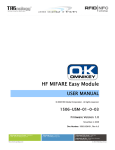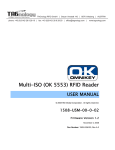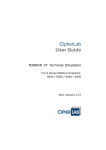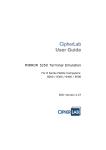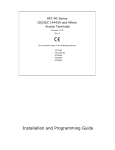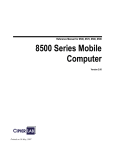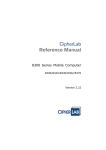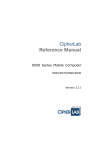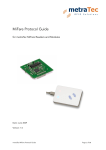Download OMNIKEY HF MIFARE Easy Module
Transcript
HF MIFARE Easy Module
USER MANUAL
Firmware Version 1.0
1506-USM-01-0-01
HF MIFARE Easy Module
User Manual, Firmware V1.0
Warning - Read before start-up!
Page 2 of 63
•
The product may only be used for the intended purpose designed by for the
manufacturer. The operation manual should be conveniently kept available at all times
for each user.
•
Unauthorized changes that have not been sold or recommended by the manufacturer
may have a negative influence on the system the program has been installed or copied
on. Such unauthorized measures shall exclude any liability by the manufacturer.
•
The liability-prescriptions of the manufacturer in the issue valid at the time of purchase
are valid for the device. The manufacturer shall not be held legally responsible for
inaccuracies, errors, or omissions in the manual or automatically set parameters for a
device or for an incorrect application of a device.
•
Only qualified personnel should carry out installation, operation, and maintenance
procedures.
•
Use of the program and its installation must be in accordance with national legal
requirements.
•
When working on devices the valid safety regulations must be observed.
•
International copyrights are applicable to this program. Unauthorized copying,
distribution or resale of this program or of parts of this program is a violation of
applicable laws and will be prosecuted.
November 4, 2008
HF MIFARE Easy Module
1506-USM-01-0-03
User Manual, Firmware V1.0
Read Me First
About This Guide
This manual describes the HF MIFARE Easy Read/Write Module. Its goal is to describe the
reader, how it works, how to integrate it and how to use it.
November 4, 2008
Page 3 of 63
1506-USM-01-0-01
HF MIFARE Easy Module
User Manual, Firmware V1.0
Contents
Warning - Read before start-up! ........................................................................................................... 2
Read Me First.......................................................................................................................................... 3
Scope .................................................................................................................................................... 6
Extended Documentation...................................................................................................................... 6
Overview ................................................................................................................................................. 6
1
Supported Tags......................................................................................................................... 8
2
MIFARE® transponder family ................................................................................................... 9
3
Hardware.................................................................................................................................. 16
4
Software ................................................................................................................................... 22
5
Frequently Asked Questions ................................................................................................. 45
References............................................................................................................................................ 49
Appendix A: Compact P&P Module ................................................................................................... 50
Appendix B: Short Range P&P Module ............................................................................................. 55
Appendix C: Timings ........................................................................................................................... 59
Appendix D: Version History .............................................................................................................. 60
Appendix E: Approvals / Certificates................................................................................................. 61
List of Figures
Figure 2-1: State diagram.............................................................................................................................. 9
Figure 2-2: MIFARE® Standard: sector diagram ......................................................................................... 10
Figure 2-3: MIFARE® Standard: sector 0 / block 0...................................................................................... 11
Figure 2-4: MIFARE® Standard: block 3, 7, 11, 15, …................................................................................ 11
Figure 2-5: MIFARE® 4k sector index table ................................................................................................ 12
Figure 2-6: DESFire memory organization.................................................................................................. 13
Figure 2-7: DESFire State diagram............................................................................................................. 14
Figure 3-1: Pin out of J1 .............................................................................................................................. 17
Figure 3-2: Electrical characteristics of pins................................................................................................ 17
Figure 3-3: Pin out of J2 .............................................................................................................................. 18
Page 4 of 63
November 4, 2008
HF MIFARE Easy Module
1506-USM-01-0-03
User Manual, Firmware V1.0
Figure 3-4: Electrical characteristics of pins................................................................................................ 19
Figure 4-1: ASCII protocol frame ................................................................................................................ 22
Figure 4-2: Binary Frame ............................................................................................................................ 22
Figure 4-3: EEPROM memory .................................................................................................................... 24
Figure 4-4: Protocol configuration register .................................................................................................. 25
Figure 4-5: Baud rate register ..................................................................................................................... 26
Figure 4-6: Baud rate settings ..................................................................................................................... 26
Figure 4-7: Communication settings ........................................................................................................... 26
Figure 4-8: Command overview .................................................................................................................. 27
Figure 4-9: Error codes ............................................................................................................................... 28
Figure 4-10: Time slot formula .................................................................................................................... 32
Figure 4-11: Timing diagram of time slotted answers ................................................................................. 33
Figure 4-12: Read USER port return values ............................................................................................... 37
Figure 4-13: Write User port settings .......................................................................................................... 38
Figure 5-1: Using a MIFARE® card ............................................................................................................. 48
Figure 5-2: Get a serial number from NFC.................................................................................................. 48
November 4, 2008
Page 5 of 63
1506-USM-01-0-01
HF MIFARE Easy Module
User Manual, Firmware V1.0
Scope
The MIFARE® Application Oriented Protocol is a reader Interface to communicate with MIFARE®
transponders. The major applications to be supported are:
•
Access control, Identification: Reading the serial numbers of all cards in the field.
•
Data Storage: Performing encrypted read and write operations.
•
Ticketing: Performing read, write, increment and decrement operations in an encrypted
environment.
•
Multi applications: Performing read, write, increment and decrement operations on
various sectors of the MIFARE® Standard tags using different encryption keys.
Extended Documentation
Note: All confidential materials are not part of this documentation.
You can obtain extended documentation containing that material after signing a NDA.
Overview
Definitions
Anti-collision loop
Algorithm processed to identify and handle a dialogue between reader and one or more tags in its
antenna field.
Hex notation
A hexadecimal value is noted with a following h, for example A1h has the value A1 hexadecimal.
ASCII notation
ASCII characters are listed within apostrophes, for example ‘x’ means a single x.
Page 6 of 63
November 4, 2008
HF MIFARE Easy Module
1506-USM-01-0-03
User Manual, Firmware V1.0
Abbreviations
Abbreviation
Description
ASCII
American Standard Code for Information Interchange
block
For MIFARE® Standard one block contains 16 bytes
EOF
End of frame
hex / xxh
value in Hexadecimal notation
LSB
Least Significant Bit or Byte
MSB
Most Significant Bit or Byte
PCON
Protocol Configuration byte of the reader
REQA
Request ISO Type A
RFU
Reserved for Future Use
sector
For MIFARE® Standard one sector contains 4 blocks
SID
Station ID
SN
Serial Number of a tag
SOF
Start of frame
value block
32 bit data block format. Used in ticketing application
<CR>
Carriage return (0Dh)
<LF>
Line feed (0Ah)
November 4, 2008
Page 7 of 63
Page 8 of 63
√
√
√
√
√
√
Philips
Philips
Philips
Philips
Infineon
Infineon
Infineon
®
MIFARE ProX
MIFARE® DESFire
MIFARE® Smart MX
SLE44R35S
SLE55R04/08/16
SLE66R35
√
√
√
-
√
√
√
MIFARE® Ultralight
√
Philips
√
MIFARE® 4k
√
Philips
√
-
√
-
-
√
√
√
√
√
√
√
√
√
√
√
√
√
encryption not included
encryption not included
Serial
Read Write Transfer
Comments
number bock block command
1
MIFARE® Standard
Manufacturer
1506-USM-01-0-01
User Manual, Firmware V1.0
HF MIFARE Easy Module
Supported Tags
November 4, 2008
HF MIFARE Easy Module
1506-USM-01-0-03
User Manual, Firmware V1.0
MIFARE® transponder family
2
The MIFARE® transponder family consists of various 13.56 MHz transponders IC, all according to
ISO 14443.
2.1
State Diagram
All MIFARE® cards use following state diagram.
Power Off
Reset
Reader Instruction Set
Idle
Select
REQA
ISO 14443 Commands
Ready
Select
Halt
Wake Up
Log In
Active
read/write/...
Halt
Anticollision Loop
Authenticate
Authenticated
Tag interfacing
commands
Figure 2-1: State diagram
November 4, 2008
Page 9 of 63
1506-USM-01-0-01
HF MIFARE Easy Module
User Manual, Firmware V1.0
2.2
MIFARE® Standard
The MIFARE® Standard card consists of 16 sectors. A sector includes four blocks 16 bytes each.
MIFARE® Standard
Sector 2
Sector 0 (Block: 0...3)
Block 8:
Data or value (16 bytes)
Sector 1 (Block: 4...7)
Block 9:
Data or value (16 bytes)
Sector 2 (Block 8...11)
Block 10:
Data or value (16 bytes)
...
Block 11:
Access Conditions (4 bytes),
Key A, Key B (16 bytes)
Sector 15 (Block 60...63)
Figure 2-2: MIFARE® Standard: sector diagram
2.2.1
Definitions
Sector
Memory segment of the MIFARE® Standard Card. Each segment consists of 4
blocks and has individual keys and access conditions. Typically in a multiapplication environment, each block is assigned to an application.
Key
6 byte structure assigned to each sector of the card. The reader may store up to
32 keys in its EEPROM or one key in its RAM.
Transport Key
Key as stored after delivery from the manufacturer.(for example A0A1A2A3A4A5,
B0B1B2B3B4B5 or FFFFFFFFFFFF)
Block
16 byte memory segment of the MIFARE® Standard card.
Value
4 byte (unsigned long) variable stored in a special format in a block or page.
Values are 2s complement numbers that can be negative also. Values are used
for cashless payment. Values consume a complete block each using redundancy
for integrity checking.
Card ID
4 byte unique serial number (single size type). Together with manufacturer code
and check byte 16 bytes. Read-only. It Is stored in block 0 (sector 0) of each tag.
Page 10 of 63
November 4, 2008
HF MIFARE Easy Module
1506-USM-01-0-03
User Manual, Firmware V1.0
2.2.2
Sector 0 / Block 0
Block 0 is read only.
Serial Number (4 byte)
Check byte (1 byte)
Manufacturer data (11 byte)
Figure 2-3: MIFARE® Standard: sector 0 / block 0
2.2.3
Block 3, 7, 11, 15 …
Transport keys are set on delivery:
Key A (6 byte)
Access Conditions (4 bytes)
Key B (6 byte)
®
Figure 2-4: MIFARE Standard: block 3, 7, 11, 15, …
Key A
A0 A1 A2 A3 A4 A5 (Infineon) or FF FF FF FF FF FF (new Philips cards)
Key B
B0 B1 B2 B3 B4 B5 (Infineon) or FF FF FF FF FF FF (new Philips cards)
Access Conditions
FF 07 80 xx (key A used to read or write, the key A itself is not readable; key B is data only). For
further information refer to Frequently asked questions or MIFARE® card manual.
Remarks
Enabled keys are always read as 00 00 00 00 00 00
Using key B as data area will cause a security gap, due to the fact that it is necessary to rewrite
key A and access conditions each write process. It is not recommended to use it as data storage.
2.3
MIFARE® Ultralight
MIFARE® Ultralight cards have no encryption included. They only support plain text data
transmission.
MIFARE® Ultralight are only supporting 4 byte per sector, but the command set uses 16 byte per
sector. Only the 4 least significant bytes are valid when using MIFARE® Ultralight.
Ensure that the other bytes matching with tag content when using the write command, otherwise
the read back will fail.
November 4, 2008
Page 11 of 63
1506-USM-01-0-01
HF MIFARE Easy Module
User Manual, Firmware V1.0
2.4
MIFARE® 4k
MIFARE® 4k cards have an increased memory. Beginning from sector 32 (20h) a sector has 16
blocks. Due to compatibility reasons the sector indices has changed according following figure.
The login sector has to be used to access the according sector on the card.
Sector
Block
Login sector
00h
00h – 03h
00h
01h
04h – 07h
01h
…
…
…
1Fh
7Ch – 7Fh
1Fh
20h
80h – 8Fh
20h
21h
90h – 9Fh
24h
22h
A0h – AFh
28h
23h
B0h – BFh
2Ch
24h
C0h – CFh
30h
25h
D0h – DFh
34h
26h
E0h – EFh
38h
27h
F0h – FFh
3Ch
Figure 2-5: MIFARE® 4k sector index table
2.5
MIFARE® ProX
MIFARE® ProX tags have an operating system onboard. Data organization depends on the
operating system installed on the card. These cards can include additional functionalities such as
DES or a proprietary encipher algorithm.
Prior to any access of the operating system the card must be selected. Customized commands
are issued using the transfer command.
Page 12 of 63
November 4, 2008
HF MIFARE Easy Module
1506-USM-01-0-03
User Manual, Firmware V1.0
2.6
MIFARE® DESFire
This tag supports additional security algorithms (DES, Triple-DES, MAC) for security sensitive
applications.
DESFire tags are addressed using a specific command set (see DESFire command set).
2.6.1
Memory organization
The memory of a DESFire card can be personalized to own requirements. The card can be seen
as data storage like a hard disk in a PC. The memory is divided in up to 28 different applications
(directories) and with 16 files each. An application has up to 14 keys. Depending on keys and
access conditions a file can be accessed in four different ways. Plain data is never secured. Data
is secured using a MAC, single DES or triple DES enciphers.
Following figure describes the memory organization of a DESFire card.
DESFire card (Application 0)
Application 1
File
ID 1
File
ID 3
Application 2
File
ID 2
…
File
ID 1
File
ID 2
File
ID 3
…
…
Figure 2-6: DESFire memory organization
November 4, 2008
Page 13 of 63
1506-USM-01-0-01
HF MIFARE Easy Module
User Manual, Firmware V1.0
2.6.2
State diagram of DESFire
Activate DESFire card
Select Application
Login to Application
Select File with ID
Change File
Commit / Abort Transaction
Figure 2-7: DESFire State diagram
2.6.2.1 Activate PICC
Prior to any access to a DESFire card the card must be selected. A DESFire card has 7 bytes
UID. After activation the card is powered up and ready to accept a DESFire command. Application
0 is selected automatically.
2.6.2.2 Select application with ID
To jump into another application it has to be selected. An application can be seen as a directory,
which contains up to 16 files. The size of the application depends on the stored files.
Page 14 of 63
November 4, 2008
HF MIFARE Easy Module
1506-USM-01-0-03
User Manual, Firmware V1.0
2.6.2.3 Login to application
Each application can be set to specific access rights. A login to an application allows changing the
application organization. Login to a file opens a secured file for access. A file can be accessed in
four different ways: plain with no security, secured with MAC, single DES or triple DES.
2.6.2.4 Select file with ID
Prior to any access to a file a file must be selected
2.6.2.5 Change file
A selected file can be changed according its access rights. If a file is secured a login is needed
before.
2.6.2.6 Commit/ Abort transaction
Value files, backup files, linear record files and cyclic record files only adapt its value after the
commit transaction command. Several files can be changed within an application at the same
time. The abort transactions command is where all changes within an application are annulated.
Power loss will cancel all modifications too.
For more details about the application settings and access rights refer to [2].
November 4, 2008
Page 15 of 63
1506-USM-01-0-01
HF MIFARE Easy Module
User Manual, Firmware V1.0
3
Hardware
3.1
Dimensions
All dimensions are listed in mm.
20
1,27
1
J1
2,54
30,50
29,21
1,27
J2
11
25,40
10
Top view
Page 16 of 63
November 4, 2008
HF MIFARE Easy Module
1506-USM-01-0-03
User Manual, Firmware V1.0
3.1.1
Pin out of J1
PIN
PIN No.
Description
ARX
1
Antenna RX
ATX1
2
Antenna TX1
VDD
3
Supply Voltage
GND
4
Ground
ATX2
5
Antenna TX2
TGND
6
Antenna Ground
RFU
7
Reserved for future use
RFU
8
Reserved for future use
RFU
9
Reserved for future use
RFU
10
Reserved for future use
Figure 3-1: Pin out of J1
3.1.2
Electrical characteristics of J1 PINs
PIN
PIN No.
Min
ARX
1
1.1V
ATX1
2
VDD
3
Typ.
13,56 MHz
Max.
Description
4.4V
Antenna RX
Antenna TX1
34 VPP
13.56MHz
100 mAPP
50VPP
+4.5V
+5.0V
+5.5V
Supply Voltage
32mA
150mA
250mA
Supply Current
GND
4
GND
ATX2
5
13,56 MHz
TGND
6
RFU
7
Do not connect
RFU
8
Do not connect
RFU
9
Do not connect
RFU
10
Do not connect
34 VPP
Ground
13.56MHz
100 mAPP
50VPP
GND
Antenna TX2
Antenna Ground
Figure 3-2: Electrical characteristics of pins
November 4, 2008
Page 17 of 63
1506-USM-01-0-01
HF MIFARE Easy Module
User Manual, Firmware V1.0
3.1.3
Pin out of J2
PIN
PIN No.
Description
RX
11
RX from PC
TX
12
TX to PC
DIR
13
Direction of RS 485
USER
14
User Port
RES
15
Hardware reset if logic low
EN
16
Enable reader, open or logic high
LEDr
17
LED red
LEDg
18
LED green (reading LED)
GND
19
Ground
VDD
20
Supply Voltage
Figure 3-3: Pin out of J2
3.1.4
Electrical characteristics of J2 PINs
PIN
PIN No.
Min
Typ.
Max.
Description
1
25 mA
RX to PC
To RS232, RS485 or RS422 device
driver
RX
11
USART-TTL
TX
12
USART-TTL1
25 mA
TX to PC
To RS232, RS485 or RS422 device
driver
DIR
13
TTL
25 mA
Direction of RS 485
Logic High = Reader to Host
Logic Low = Host to Reader
USER
14
TTL 2
25 mA
User Port
RES
15
TTL 3
EN
16
TTL 4
25 mA
Enable reader
logic low will disable the reader
Open or logic high
LEDr
17
VDDtyp
@ 11mA
VDDmax
@ 0 mA
LED red
Output Voltage
11mA
25mA
External Resistor
min. 200 Ω
VDDmin
@ 25mA
On logic low, hardware will be reset
1
Universal Synchronous Asynchronous Receiver Transmitter
2
TTL buffer output / input
3
Voltage spikes below GND at the RES/VDD pin, including currents greater than 80mA, may cause latchup. Thus, a series resistor of 50-100Ω should be used when applying a "low" level to the RES/VDD, rather
than pulling this pin directly to GND.
4
Schmitt trigger buffer input
Page 18 of 63
November 4, 2008
HF MIFARE Easy Module
1506-USM-01-0-03
User Manual, Firmware V1.0
PIN
PIN No.
LEDg
18
GND
19
VDD
20
IDD
Min
Typ.
Max.
Description
1.4V
@ 11mA
VDD
@ 0mA
LED green (reading LED)
with 330 Ω (internal serial) resistor
11mA
15mA
GND
Ground
+4.5V
+5.0V
+5.5V
Supply Voltage
32 mA
150 mA
250 mA
Supply Current
Figure 3-4: Electrical characteristics of pins
3.1.5
External Connections
3.1.5.1 Power Supply
If the supply voltage and any noise modulated on the supply voltage remains within the specified limits, no
further filtering is required. In some cases it is recommended to use additional filtering for the power
supply line. Insufficient power line filtering could cause unexpected or irregular performance drops.
Option 1
+5V DC
OEM Board
20
19
uC
Option 2
+5V DC
OEM Board
3
4
The board can be connected as shown above. Both alternatives are possible and can be used as
they fit best into the layout of the carrier board. The two VDD PINs and the two GND PINs are
connected internally.
November 4, 2008
Page 19 of 63
1506-USM-01-0-01
HF MIFARE Easy Module
User Manual, Firmware V1.0
3.1.5.2 Antenna
The typical antenna tuning and matching network is shown below. The external antenna has to
have the right inductance and a certain resistor and capacitor combination for an optimized
frequency tuning and antenna matching.
R1
C1
L ANT
C3
C5
C4
1
2
OEM Board
5
6
C2
Please refer also to the specific application notes for the Philips reader IC (MIFARE® & I-Code,
Micore Reader IC family Directly Matched Antenna Design).
3.1.5.3 Serial Interface
The OEM Board can be connected directly with a micro controller. Alternatively the OEM Board
also can be connected to most serial interface types by using the right interface converter circuit.
In order to optimize the communication quality the specific application note of the interface
converter circuit needs to be taken into consideration.
OEM Board
Page 20 of 63
12
11
Interface
Converter
Circuit
Host Interface
November 4, 2008
HF MIFARE Easy Module
1506-USM-01-0-03
User Manual, Firmware V1.0
3.1.5.4 Function Control LEDs
Two external LEDs can be connected to the OEM Board. There are two alternatives possible.
Option 1
OEM Board
330 Ohm
uC
18
17
Option 2
OEM Board
330 Ohm
uC
18
17
330 Ohm
In both cases the LED supply voltage levels are TTL levels.
November 4, 2008
Page 21 of 63
1506-USM-01-0-01
HF MIFARE Easy Module
User Manual, Firmware V1.0
4
Software
As default data is transmitted at 9600,n, 8,1, no handshaking. Two protocol modes are supported.
The protocol mode is configured in the reader EEPROM. As factory default, the ASCII protocol is
used.
4.1
ASCII Protocol
This protocol is designed for easy handling. The commands are issued using a terminal program.
Data is transmitted as ASCII hexadecimal that can be displayed on any terminal program (for
example HyperTerminal).
Command
Data
Various length
Various length
Figure 4-1: ASCII protocol frame
4.2
Binary Protocol
This protocol is designed for industrial applications with synchronization and frame checking. Also
an addressing byte for party line (master slave, multi drop) is included.
The protocol usually requires a device driver. Data is transmitted binary. The reader uses a binary
watchdog timer internally to ensure correct framing.
STX
Station ID
Length
Data
BCC
ETX
1 byte
1 byte
1 byte
Various length
1 byte
1 byte
Figure 4-2: Binary Frame
4.2.1
STX
Start of transmission (02h)
4.2.2
Station ID
Unique ID of the station
00h: reserved for the bus master. Readers send response to this device ID.
FFh: Broadcast message. All devices will execute the command and send its response.
4.2.3
Length
Data Length Indicator.
Denotes the length of the Data block.
Page 22 of 63
November 4, 2008
HF MIFARE Easy Module
1506-USM-01-0-03
User Manual, Firmware V1.0
4.2.4
Data
This part contains the command and data. The command values are the same as in ASCII
protocol mode (‘x’, ‘s’, …) whereas data is transmitted binary.
The length of the command block depends on the instruction.
4.2.5
Block Check Character (BCC)
The BCC is used to detect transmission errors. The BCC is calculated XOR-ing each byte of the
transmission frame excluding the STX/BCC and ETX character.
BCC = ( StatID) XOR ( Length) XOR ( Data 0 ) XOR ... XOR ( Data N )
4.2.6
ETX
End of transmission. (03h)
4.2.7
Remarks
If the reader device receives an invalid instruction frame (for example BCC wrong) or the
requested station ID does not match the internal ID of the reader, the command is not executed.
The reader waits for the next valid frame.
The automatic binary timeout (see protocol configuration register) is used to detect incomplete
binary frames.
The reader module answers in the same telegram format, with the ID-field set to 0. The Data block
of the answers in binary protocol mode does match the ASCII mode answers, with the only
difference that data values are transmitted binary instead of ASCII Hex.
November 4, 2008
Page 23 of 63
1506-USM-01-0-01
HF MIFARE Easy Module
User Manual, Firmware V1.0
4.2.8
Examples
02h
64h
01h
78h
1Dh
03h
STX
Station ID
Length
‘x’
BCC
ETX
This instruction frame will reset the reader module with the station ID 64h.
4.3
Register Set
The reader has several system flags to customize its behavior. The flags are stored non-volatile in
its EEPROM. The reader accepts changes of the setting only during the start up phase. It is
recommended to clear all RFU bits to guarantee further compatibility.
The reader is able to store up to 32 authentication keys to log in Standard MIFARE® cards
internally. All keys are read only and cannot be accessed via the interface lines.
4.3.1
EEPROM memory organization
Register
Description
00h … 03h
Unique device ID; read only
04h
Station ID
05h
Protocol configuration
06h
Baud rate
07h
Reset Off Time
08h
Reset Recovery time
09h
Internal use / Do no change
0Ah ... 0Fh
RFU
10h … 13h
User data
Figure 4-3: EEPROM memory
4.3.2
Unique device ID (00h – 03h)
The unique device ID identifies a reader module. It is factory programmed and cannot be
changed.
4.3.3
StationID (04h)
The station ID is used in binary mode to address a device in party line set up. The station ID has
the range of 01h to FEh and can be set freely. The value 00h is reserved for the bus master. All
readers send their response to this device.
The broadcast message (FFh) forces all readers to response to the command.
Default value is 01h.
Page 24 of 63
November 4, 2008
HF MIFARE Easy Module
1506-USM-01-0-03
User Manual, Firmware V1.0
4.3.4
Protocol configuration (05h)
The protocol configuration register (PCON) specifies general behavior of the reader device.
Default value is 01h.
Protocol configuration register
Bit 7
Bit 6
Bit 5
Bit 4
Bit 3
Bit 2
Bit 1
RFU
RFU
RFU
Multitag
Binary
Timeout
Extend ID Binary
Bit 0
Auto Start
Figure 4-4: Protocol configuration register
4.3.4.1 Autostart (default 1)
If set the reader device will start up in continuous read mode automatically.
4.3.4.2 Protocol (default 0)
If set the reader uses binary protocol mode. Refer to binary protocol for further information on the
binary protocol format.
Default setting = ASCII protocol (0).
Extended ID (default 0)
This setting does only affect the commands continuous reading (‘c’), select (‘s’) and multi tag
select (‘m’).
If set a the unique serial number of the transponder is extended by a single prefix byte.
The values for the prefix byte are:
prefix
description
01h
MIFARE® Light Transponder
02h
MIFARE® Standard Transponder
03h
MIFARE® 4k Transponder
04h
MIFARE® ProX Transponder
05h
MIFARE® UltraLight Transponder
06h
MIFARE® DESFire Transponder
FFh
Unknown Transponder
4.3.4.3 Binary Timeout (default 0)
This flag is only interpreted if the reader operates in binary mode.
If the serial bus stays idle for more than 96 ms (no data is transmitted), the reader will clear its
command buffer and enter “Command Read” mode.
The “Command Read” mode means that the reader is waiting for valid data frames (beginning
with the STX code).
November 4, 2008
Page 25 of 63
1506-USM-01-0-01
HF MIFARE Easy Module
User Manual, Firmware V1.0
4.3.4.4 Multitag (default 0)
The Multitag flag will enable multi tag recognition in continuous read mode. All tags are detected
and displayed. Due to the more complex search algorithm the continuous read command
decreases its detection speed.
4.3.5
BAUD, Baud rate control register (06h)
The baud rate register defines the communication speed of the reader device.
Default value is 00h.
Baud rate register
Bit 7
Bit 6
Bit 5
Bit 4
Bit 3
Bit 2
Bit 1
Bit 0
RFU
RFU
RFU
RFU
RFU
RFU
BS1
BS0
Figure 4-5: Baud rate register
This register defines the baud rate of the device.
BS1
BS0
Baud rate
0
0
9600 baud (default)
0
1
19200 baud
1
0
38400 baud
1
1
57600 baud
Figure 4-6: Baud rate settings
Following figure describes the communication settings
Description
8 data bits
No parity bit
1 stop bit
No flow control
Figure 4-7: Communication settings
4.3.6
Reset Off Time (07h)
The Reset Off Time register represents the field off time in ms.
This register is used for the select, continuous read and multi tag commands.
Default value is 10h.
4.3.7
Reset Recovery Time (08h)
The Reset Recovery Time register represents the recovery time in ms after the field is turned on.
This register is used for the select, continuous read and multi tag commands.
Default value is 10h.
Page 26 of 63
November 4, 2008
HF MIFARE Easy Module
1506-USM-01-0-03
User Manual, Firmware V1.0
4.3.8
User data (10h - 13h)
These registers are for free use.
4.4
Instruction Set
Following table describes all commands of the reader device. Each command returns an answer
to the host. Exceptions are mentioned explicitly. The green LED is acknowledging a successfully
executed command. The red LED indicates an error.
4.4.1
Overview
Common commands
'+'
Increment value block (credit)
'-'
Decrement value block (debit)
'='
Copy value block (backup)
'c'
Continuous read
'g'
Get Station ID
'l'
Login (authenticate tag)
'm'
MultiTag select / tag list
'poff' / 'pon'
Antenna power off/on
'pr' / 'pw'
Read / write user port
'r' / 'rb'
Read block
're'
Read EEPROM register
'rv'
Read value block
's'
Select
'v'
Get version
'w' / 'wb'
Write block
'we'
Write EEPROM register
'wm'
Write master key
'wv'
Write value block
'x'
Reset
Figure 4-8: Command overview
November 4, 2008
Page 27 of 63
1506-USM-01-0-01
HF MIFARE Easy Module
User Manual, Firmware V1.0
4.4.2
Error Codes
Following figure shows an overview of all error messages of the reader device.
Error Code
Description
‘?’
Unknown command
'E'
Invalid key format
‘F’
General failure
‘I’
Invalid value format, specified block does not match the value format
‘N’
No tag in the field
'O'
Operation mode failure
'U'
Read after write failure
'X'
Authentication failed
Figure 4-9: Error codes
4.4.3
Common commands
4.4.3.1 Increment value block (credit)
Increments a value block with a defined value. A read after write is done automatically to verify
data integrity. The command fails if the source block is not in value block format. A previous log in
is needed to access a block.
Command
Command
Data
'+'
Block (1 byte)
Value (4 bytes)
Answer
Answer
Description
Data
Value (4 bytes)
'I'
Error: value block failure
'F'
Error: increment failure
'N'
Error: No tag in field
'X'
Error: Unable to read after write
Example
Command
Description
+0400000001
adds 1 to value block 4
+0500000100
adds 256 to value block 5
4.4.3.1.1
No value block 'I'
Specified block does not match the value format. The value block is corrupted. A backup block
can be used to restore the correct value.
Page 28 of 63
November 4, 2008
HF MIFARE Easy Module
1506-USM-01-0-03
User Manual, Firmware V1.0
4.4.3.1.2
Increment failure 'F'
General failure during increment procedure or unable to read after write.
4.4.3.1.3
No tag error 'N'
The reader does not detect a response of the tag. There is either no tag present or the tag does
not respond the request.
4.4.3.1.4
Unable to read after write 'X'
The tag was removed from field immediately after increment instruction.
Data was decremented but the tag did not respond to the read after increment instruction, which is
done automatically by the reader module.
4.4.3.2 Decrement value block (debit)
Decrements a value block with a defined value. A read after write is done automatically to verify
data integrity. The command fails if the source block is not in value block format. A previous log in
is needed to access a block.
Command
Command
Data
'-'
Block (1 byte)
Value (4 bytes)
Answer
Answer
Description
Data
Value (4 bytes)
'I'
Error: value block failure
'F'
Error: increment failure
'N'
Error: No tag in field
'X'
Error: Unable to read after write
Example
Command
Description
-0400000001
subtract 1 to value block 4
-0500000100
subtract 256 to value block 5
4.4.3.2.1
No value block 'I'
Specified block does not match the value format. The value block is corrupted. A backup block
can be used to restore the correct value.
4.4.3.2.2
Decrement failure 'F'
General failure during decrement procedure or unable to read after write.
4.4.3.2.3
No tag error 'N'
The reader does not detect a response of the tag. There is either no tag present or the tag does
not respond the request.
November 4, 2008
Page 29 of 63
1506-USM-01-0-01
HF MIFARE Easy Module
User Manual, Firmware V1.0
4.4.3.2.4
Unable to read after write 'X'
The tag was removed from field immediately after decrement instruction.
Data was decremented but the tag did not respond to the read after decrement instruction, which
is done automatically by the reader module.
4.4.3.3 Copy value block (backup)
Copies a value block to another block of the same sector. A read after write is done automatically
to ensure data integrity. Used for backup and error recovery. A previous log in is needed to access
a block.
Command
Command
Data
'='
Source block (1 byte)
Target block (1 byte)
Answer
Answer
Description
Data
New value of target block (4 bytes).
'I'
Error: value block failure
'F'
Error: increment failure
'N'
Error: No tag in field
'X'
Error: Unable to read after write
Example
Command
Description
=0405
copy value block 4 to block 5
=0506
copy value block 5 to block 6
4.4.3.3.1
Target block
The target block needs not to be a valid value block. If source block is not in value format the
command fails.
4.4.3.3.2
No value block 'I'
Source value block does not match the value format. The value block is corrupted. A backup block
can be used to restore the correct value.
4.4.3.3.3
Copy failure 'F'
General failure during copy procedure or unable to read after write.
4.4.3.3.4
No tag error 'N'
The reader does not detect a response of the tag. There is either no tag present or the tag does
not respond the request.
Page 30 of 63
November 4, 2008
HF MIFARE Easy Module
1506-USM-01-0-03
User Manual, Firmware V1.0
4.4.3.3.5
Unable to read after write 'X'
The tag was removed from field immediately after copy instruction.
Data was decremented but the tag did not respond to the read after copy instruction, which is
done automatically by the reader module.
4.4.3.4 Continuous Read
The reader device reads and displays serial numbers continuously while one or more tags remain
in the field. This command stops if any character is sent to the reader module.
The reader supports different tag types at the same time. To increase the reading performance
switch to a single tag mode. If more than one tag of the same tag type should be detected at the
same time the Multitag flag must be activated. The response data length depends on the tag type.
Command
Command
Data
'c'
none
Answer
Answer
Description
data
serial number (n bytes)
'N'
Error: No Tag in the field (only binary protocol)
4.4.3.4.1
Multitag continuous read mode
If the Multitag flag is set in the Protocol Configuration (PCON) register the reader reads multiple
tags continuously.
4.4.3.4.2
Auto start
The continuous read mode is started automatically. The auto start flag must be set in the PCON
register.
4.4.3.4.3
Binary mode
This command is not fully supported in binary protocol mode.
Continuous Read in binary mode does not startup automatically at boot time, even if the
corresponding EEPROM flag is set.
Within the single shot timeout only one response is sent.
4.4.3.4.4
Simple access control applications
Serial numbers are always sent plain. Data encryption is activated after a successful log in.
For simple access control applications it is recommended to use read-only blocks for the
identification of the tag.
Reading any block (even the manufacturer block) of the transponder will increase your security.
November 4, 2008
Page 31 of 63
1506-USM-01-0-01
HF MIFARE Easy Module
User Manual, Firmware V1.0
4.4.3.4.5
Extended ID
If Extended ID is activated a prefix byte extends the serial number. For more information refer to
Protocol Configuration register.
4.4.3.5 Get Station ID
This command returns the station ID of the reader device. The answer is time slotted to enable
that all devices in party line mode are detected.
The station ID has only effect in binary mode.
Command
Command
Data
'g'
None
Answer
Answer
Description
Data
Station ID of the reader device (1 byte)
4.4.3.5.1
Time slotted answer
In party line mode more than one reader can be used simultaneously. The time slotted answer
allows separating all connected devices. The station ID is used to determine the correct time slot.
The reader supports up to 254 unique time slots. Following formula calculates the needed time of
one time slot. Only one baud rate on the same party line is supported.
T0 [ s ] =
10
*6
Baudrate
Figure 4-10: Time slot formula
Page 32 of 63
November 4, 2008
HF MIFARE Easy Module
1506-USM-01-0-03
User Manual, Firmware V1.0
Following figure shows the timing diagram of time slotted answers.
timeslot
HOST
reader (01)
reader (03)
reader (04)
0
1
T0
T1
2
3
4
5
T2
T3
T4
T5
…
252
253
254
T253
T254
T255
'g' →
← 01
← 03
← 04
← 254
reader (254)
Figure 4-11: Timing diagram of time slotted answers
November 4, 2008
Page 33 of 63
1506-USM-01-0-01
HF MIFARE Easy Module
User Manual, Firmware V1.0
4.4.3.6 Login (authenticate tag)
Performs an authentication to access one sector of a MIFARE® card. Only one sector can be
accessed at the same time.
Optionally to transmit the key data to the reader stored keys, in the reader EEPROM, can be used.
To store keys in the EEPROM the write master key command is used. It is possible to store up to
32 master keys in the reader EEPROM. The login requires a successful select.
Command
Command
Data
'l'
Sector (1 byte) ), valid range 00h - 3Fh
Key type (1 byte)
AAh authenticate with key type A
FFh authenticate with key type A, transport key
FFFFFFFFFFFFh
BBh authenticate with key type B
10h … 2Fh authenticate with key type A using stored
key (00h … 1Fh)
30h … 4Fh authenticate with key type B using stored
key (00h … 1Fh)
Key (6 bytes) / <CR> (1 byte), optional
By transmitting <CR> instead of the keydata
authentication is done with manufacturers transport
keys (A0A1A2A3A4A5h, B0B1B2B3B4B5h,
FFFFFFFFFFFFh).
Answer
Answer
Description
data
Login status (1 byte)
'L'
Login success
'E'
Error: Invalid key format
'F'
Error: General failure
'N'
Error: No tag
Example
Command
Description
l02AA<CR>
Authenticate for sector 2, using the transport key A
(A0A1A2A3A4A5h, key type A)
l3FBB<CR>
Authenticate for sector 63, using the transport key 2
(B0B1B2B3B4B5h, key type B)
l04FF<CR>
Authenticate for sector 4, using the transport key 3
(FFFFFFFFFFFFh, key type A)
l0FAAFFFFFFFFFFFF
Authenticate for sector 15, using key FFFFFFFFFFFFh, key type A
l0E14
Authenticate for sector 14, using EEPROM key 4, key type A
l0530
Authenticate for sector 5, using EEPROM key 0, key type B
l0732
Authenticate for sector 7, using EEPROM key 2, key type B
l0110
Authenticate for sector 1, using EEPROM key 0, key type A
l0ABBFF12FFFFFF35
Authenticate for sector 10, using key FF12FFFFFF35h, key type B
Page 34 of 63
November 4, 2008
HF MIFARE Easy Module
1506-USM-01-0-03
User Manual, Firmware V1.0
4.4.3.6.1
No tag error 'N'
The reader does not detect a response of the tag. There is either no tag present or the tag does
not respond the request.
4.4.3.6.2
<CR>
Three transport keys are implemented to access cards fast.
Transmitting <CR> instead of the key the reader module uses transport keys for the login
procedure.
Command
Description
LxxAA<CR>
Authenticate for sector xx, using the transport key A
(A0A1A2A3A4A5h, key type A)
LxxBB<CR>
Authenticate for sector xx, using the transport key 2
(B0B1B2B3B4B5h, key type B)
LxxFF<CR>
Authenticate for sector xx, using the transport key 3
(FFFFFFFFFFFFh, key type A)
4.4.3.6.3
Login with keydata from EEPROM
Each key stored in the reader EEPROM can be used as keytype A or keytype B. To use a key as
type A the value 10h must be added to the key index. 30h must be added to use a key as type B.
4.4.3.6.4
Usage of key A, key B
MIFARE® cards support two different crypto keys for each sector. Each key is 32 bit long and is
stored in the sector trailer (last block of the sector) on a card. It is possible to set different access
rights for each key.
4.4.3.7 Multi Tag Selection / List
This command detects several tags at the same time. It replaces the fast select command ('s') in
multiple tag surroundings. The Multi Tag list command lists all tags with its serial numbers. Use
the Multi Tag Select command to select a single tag. Each tag has to be selected separately.
Command
Command
Data
'm'
Serial number (n bytes)
<CR> (1 byte)
Answer
Answer
Description
Data
serial number
'N'
Error: No Tag in the field
November 4, 2008
Page 35 of 63
1506-USM-01-0-01
HF MIFARE Easy Module
User Manual, Firmware V1.0
Example
Command
Description
m<CR>
04E9E700000000
34030F07
02
m04E9E700000000<CR>
Select card with its serial number
Æ first card
Æ second card
Æ number of detected tags
4.4.3.7.1
Multi tag list
Sending a <CR> as first parameter the reader returns a list of all present tags in the antenna field.
In the end the amount of detected tags are returned.
4.4.3.7.2
Reading distance
Each card needs a specific amount of power. The reader always provides the same power.
Therefore the reading distance will decrease if more tags are present. Basically, the reading
distance depends on the used tag, antenna and its tuning.
4.4.3.7.3
Multi tag select
Using the serial number with <CR> as parameter the according tag will be selected. High-level
interactions can be performed addressing only this card. All other tags remain silent.
4.4.3.7.4
Multi tag reset
The antenna field reset can be deactivated with Protocol configuration 2 register.
By suppressing the antenna field reset it is possible to detect only new tags in the antenna field.
4.4.3.7.5
Maximum number of tags
The maximum number of tags in the antenna field is limited to the physical characteristics of the
antenna.
The implementation detects up to 16 tags.
4.4.3.8 Antenna power on/off
This command controls the antenna power. It can be used to decrease the power consumption of
the reader.
Command
Command
Data
'pon'
Switch on reader
'poff'
Reader enters the stand by mode
Answer
Answer
Description
'P'
Positive acknowledge
Example
Command
Description
poff
Reader enters stand by mode
Page 36 of 63
November 4, 2008
HF MIFARE Easy Module
1506-USM-01-0-03
User Manual, Firmware V1.0
4.4.3.8.1
Power off
The reader enters the stand by mode. Power consumption is decreased. All tags in the antenna
field are powered off and reset. The stand by mode is only entered manually.
To switch off the whole unit pin 16 (Enable) has to be set to logic low.
4.4.3.8.2
Power on
The reader leaves the stand by mode and is ready for the next command. Sending a tag
command (for example select, continuous read) the reader is powered up.
4.4.3.8.3
Reset Timing
The power up timing depends on environmental conditions such as voltage ramp up.
4.4.3.9 Read/Write user port
This command sets or reads the state of the user port (pin 14) of the OEM reader device. The port
is set either as output or as input.
Command
Command
Data
'pr'
none
'pw'
State of user port (1 Byte)
Answer
Answer
Description
Data
State of user port (1 Byte)
Example
Command
Description
pr
Reads user port
pw01
Sets user port state to high
4.4.3.9.1
Read port
The port read command returns the current state of the USER port.
Port state
Description
00
USER port is low
01
USER port is high
Figure 4-12: Read USER port return values
November 4, 2008
Page 37 of 63
1506-USM-01-0-01
HF MIFARE Easy Module
User Manual, Firmware V1.0
4.4.3.9.2
Write port
If user port is used as an output a 1kΩ resistor has to be integrated into the wire. Otherwise the
reader device can be damaged.
Port state
Description
00
Sets USER port to low
01
Sets USER port to high
Figure 4-13: Write User port settings
4.4.3.10
Read block
This command reads a data block on a card. Size of returned data depends on the used tag. The
block address range depends on the present tag.
Command
Command
Data
'r'
Block address (1 byte), valid range 00h – 40h
'rb'
Block address (1 byte)
Answer
Answer
Description
Data
block data (depends on tag type)
'F'
Error: read failure
'N'
Error: No tag in field
'O'
Error: Operation mode failure
Example
Command
Description
rb05
Reads block 05.
4.4.3.10.1 Read failure 'F'
This error is returned if the reader receives either bad data or the block address exceeds the block
address range of the sector.
4.4.3.10.2 No tag in field 'N'
The tag does not respond. There is either no tag present or not addressed.
4.4.3.10.3 Operation mode failure 'O'
The block address of the 'r' command is higher than 40h.
The block address of the 'r' command conflicts with other commands, therefore the block address
has to be limited to 40h.
Use the 'rb' command instead.
Page 38 of 63
November 4, 2008
HF MIFARE Easy Module
1506-USM-01-0-03
User Manual, Firmware V1.0
4.4.3.11
Read reader EEPROM
This command reads the internal reader EEPROM. It contains all startup parameters and the
device ID. Changes of the startup settings will only be taken into effect after a reset of the device.
Command
Command
Data
're'
EEPROM address (1 byte) 00h … 13h
Answer
Answer
Description
Data
EEPROM data (1 byte)
Example
Command
Description
rp05
Reads protocol configuration register.
4.4.3.12
Read value block
Reads a value block. The command checks if data is in value block format. The read value block
command needs a successful login.
Command
Command
Data
'rv'
Value block (1 byte)
Answer
Answer
Description
Data
Read value (4 bytes)
'F'
Error: General failure
'I'
Error: value block failure
'N'
Error: No tag in field
Example
Command
Description
rv04
Reads value of block 4.
4.4.3.12.1 No value block 'I'
The value read back after the write value instruction is a not a value block. Data was written
corruptly.
4.4.3.12.2 No tag error 'N'
This means that the tag does not respond, because there is either no tag present or none of the
tags in the field is authenticated ('l' instruction).
4.4.3.12.3 General failure 'F'
Additional to a data read error caused by bad transmission conditions, this error appears if a
sector is addressed which is not located in the authenticated sector.
November 4, 2008
Page 39 of 63
1506-USM-01-0-01
HF MIFARE Easy Module
User Manual, Firmware V1.0
4.4.3.13
Select
This command selects a single card in the antenna field. It can only be used in single tag mode. In
the case of success the command returns the UID of the selected card. The reader detects the
length of the card automatically.
Command
Command
Data
's'
None
Answer
Answer
Description
Data
serial number
'N'
Error: No Tag in the field
Example
Command
Description
s
1234567890ABCD
Select the card with its UID 1234567890SABCD.
4.4.3.13.1 Select a single tag
No previous continuous read is required. The command executes an automatic field reset.
4.4.3.13.2 Extended ID
For more information of the Extended ID refer to Protocol configuration register.
4.4.3.13.3 Multiple tags
This command is designed for fast access of a single tag in the field. If multiple cards are used the
'm' instruction has to be used instead.
4.4.3.14
Get Version
This command returns the current version of the reader module.
Command
Command
Data
'v'
None
Answer
Answer
Description
'MIFARE 1.0' + <CR> + <LF>
ASCII Mode
02 00 0A 4D 69 66 61 72 65 20 31 2E 30 31 03
Binary Mode
Example
Command
Description
v
‘MIFARE 1.0’
Version of the reader module
Page 40 of 63
November 4, 2008
HF MIFARE Easy Module
1506-USM-01-0-03
User Manual, Firmware V1.0
4.4.3.15
Write block
This command writes data to a block. A read after write is done automatically to ensure correct
writing.
Command
Command
Data
'w'
Block address (1 byte), valid range 00h – 40h
Data (n bytes)
'wb'
Block address (1 byte)
Data (n bytes)
Answer
Answer
Description
Data
Block data (depends on tag type)
'F'
Error: Write failure
'N'
Error: No tag in field
'O'
Error: Operation mode failure
Example
Command
Description
wb0511223344
Writes data 11223344 on block 05.
4.4.3.15.1 Write failure 'F'
This error is displayed if bad transmission conditions are given. If the block address exceeds the
physical number of blocks of a tag this error is thrown.
4.4.3.15.2 No tag error 'N'
This error is returned if no tag is present or the card does not respond.
4.4.3.15.3 Operation mode failure 'O'
The block address of the 'w' command is higher than 40h.
The block address of the 'w' command conflicts with other commands, therefore the block address
has to be limited to 40h.
Use the 'wb' command instead.
November 4, 2008
Page 41 of 63
1506-USM-01-0-01
HF MIFARE Easy Module
User Manual, Firmware V1.0
4.4.3.16
Write EEPROM
Writes to the internal reader EEPROM. It contains all startup parameters and the device ID.
Changes of the startup settings will only be taken into effect after a reset of the device.
Command
Command
Data
'we'
Address (1 byte), valid range 04h - 13h
Data (1 byte)
Answer
Answer
Description
Data
EEPROM data (1 byte)
'F'
Error: Read after write failure
Example
Command
Description
we0401
Set EEPROM address 04 (Station ID) to 01h
4.4.3.17
Write master key
This command stores a MIFARE® Standard key into the master key memory of the reader. The
reader can store up to 32 keys.
Command
Command
Data
'wm'
Key number (1 byte) 00h … 1Fh
Key (6 bytes)
Answer
Answer
Description
data
written key (6 bytes)
'F'
Error: Write failure
Example
Command
Description
wm00112233445566
Store key 112233445566h in EEPROM (key number 0).
wm02A0A1A2A3A4A5
Store transport key 1 in EEPROM key 2.
Page 42 of 63
November 4, 2008
HF MIFARE Easy Module
1506-USM-01-0-03
User Manual, Firmware V1.0
4.4.3.17.1 Writing master keys
Keys are write only. It is not possible to read the keys. Nevertheless the reader returns correct
error messages if the writing process fails.
A verification of the master key can only be done using an appropriate card and a successful
login.
4.4.3.17.2 Using master keys for authentication
Master keys may be used for ISO-14443 A tag authentication. It is possible to use every stored for
key A as well as key B authentication.
Each key is 6 bytes long and stored redundantly for data security.
4.4.3.18
Write value block
This command formats a block as a value block containing a 32-bit value. A read after write is
performed automatically. Value blocks need a complete 16-byte block due to redundant storage. A
successful login is required to run the command.
Command
Command
Data
'wv'
Value block (1 byte)
Value (4 bytes)
Answer
Answer
Description
Data
Written value (4 bytes)
'I'
Error: value block failure
'F'
Error: increment failure
'N'
Error: No tag in field
'U'
Error: Read after write failure
Example
Command
Description
wv05010055EF
Writes value 010055EFh to block 5.
4.4.3.18.1 Invalid value 'I'
The value read back after the write value instruction is a not a value block. Data was written
corruptly.
4.4.3.18.2 Write failure 'F'
Additional to a data read error caused by bad transmission conditions; this error appears if a
sector is addressed which is not located in the authenticated sector.
4.4.3.18.3 No tag error 'N'
This error is returned if no tag is present or the card does not respond.
November 4, 2008
Page 43 of 63
1506-USM-01-0-01
HF MIFARE Easy Module
User Manual, Firmware V1.0
4.4.3.18.4 Writing values
The write value block command is designed to create blocks, which match the value format. This
command requires write access to specified block. It is not recommended to use this instruction
for ticketing operations. For ticketing applications special instructions (Increment/Decrement/Copy)
are supported.
4.4.3.19
Reset
This command executes a power on (software) reset. New configuration settings will be loaded. It
resets all tags in the antenna field.
Command
Command
Data
'x'
None
Answer
Answer
Description
'MIFARE 1.0' + <CR> + <LF>
ASCII Mode
None
Binary Mode
4.4.3.19.1 Reset Timing
The power up timing depends on environmental conditions such as voltage ramp up. For
handheld devices the timing can change on the charging state of the battery.
Page 44 of 63
November 4, 2008
HF MIFARE Easy Module
1506-USM-01-0-03
User Manual, Firmware V1.0
5
Frequently Asked Questions
5.1
Getting Started
To test and interface the MIFARE Easy Module, you do not need a sophisticated µP development
system. All you need is a PC, a connection cable and a power supply for the reader. If you are
using Microsoft Windows (95/98/NT/…), take the following steps:
•
Make sure, that your reader is RS232-interface type
•
Start HyperTerminal
•
Create a new connection (FILE/NEW CONNECTION)
•
Enter name of connection as you like (for example ‘MIFARE’)
•
Select connect COM2 (COM1) direct connection
•
Connection setup 9600,8,n,1,no handshake
•
Connect your reader to COM2 (COM1) of the PC and apply appropriate the supply
voltage. The reader transmits a string (“MIFARE 1.0”) to the PC.
•
This String denotes the firmware provided by your reader module
•
Put a tag to your reader. Serial numbers should be displayed properly
•
Enter commands via keyboard. They should be transmitted to the reader and the reader
should reply
If using an operating system different from Microsoft Windows you may use any other terminal
program which is capable of receiving/transmitting data via the serial port of your PC.
5.2
How should the MIFARE® Easy Reader be personalized?
In ASCII protocol applications, no personalization is necessary.
In applications that are using the binary protocol mode a personalization procedure is required.
Use the Utility program to set up your reader correctly.
System requirements are WIN98SE (at a minimum,) and a computer COM port.
5.3
What type of MIFARE® card should I use?
MIFARE® Standard is designed for multi application environment. It contains 16 sectors each with
2 individual keys, access conditions, 3 data or value blocks. Some applications use the 1 Kbytes
of the MIFARE® Standard Card Memory just as storage.
MIFARE® Ultralight has not a crypto unit on chip. It only supports 16 blocks.
MIFARE® Standard 4k cards have the same features as MIFARE® Standard card but increased
memory capacity.
November 4, 2008
Page 45 of 63
1506-USM-01-0-01
HF MIFARE Easy Module
User Manual, Firmware V1.0
5.4
How safe is MIFARE® Standard for cashless payment?
Security is always a property of the overall system, not of the components. It requires careful
design.
A properly designed system will require ALL barriers to be hacked in order to be broken.
For good design start specifying feasible attacks. Then create barriers to block them.
MIFARE® was specifically designed for cashless payment applications. The MIFARE® concept
provides following barriers:
•
Anti-collision/-selection
•
Atomic value transaction
•
Ciphered communication
•
Storage of values and data protected by mutual authentication
•
Weak field keys that allow decrement only
•
Stored keys in the reader that are not readable
•
Keys in the card that are not readable
•
A brute force attack by trying different keys is limited by the transaction time (several
msec) of the card and would last virtually forever.
•
etc.
The Application can and should provide more barriers:
Page 46 of 63
•
Sector access conditions. It is possible to assign access conditions in a way that only
decrementing of values is allowed with the keys used in the field. So even a
manipulated field station cannot be used to charge cards with additional values. As a
rule, key A is used as a field key, allowing decrement and read only, and key B to format
the card or charge values.
•
Diversified keys. To make life even harder for attackers, keys can be modified using
serial number and memory content of the card. So each card uses different keys and a
listening attack on the reader interface would be hopeless.
•
Limiting cash volume stored on a card
•
Do not use the transport keys (keys as programmed after delivery) for ticketing
applications!
•
Ciphered and scrambled data storage
•
Sabotage alarm
•
etc.
•
®
Even higher security with contactless controller cards like DESFire, MIFARE ProX,
®
MIFARE Smart MX etc.
November 4, 2008
HF MIFARE Easy Module
1506-USM-01-0-03
User Manual, Firmware V1.0
5.5
MIFARE® Standard Sector Trailer and Access Conditions
The last block of each sector contains configuration data for the sector. This configuration data
includes key A, key B and the access conditions. The first six byte (byte 0…5) of the Sector Trailer
contain key A data, the last six bytes (byte 10…15) contain key B data.
Byte number 6 to byte number 9 contain the access conditions for each block of the sector. It is
possible to configure the access rights (read, write, increment, decrement, restore) different for
each block in the sector and in dependence to the key used in the authentication (login)
procedure.
Access conditions for the Sector Trailer himself are different form access conditions of a data
block (increment, decrement, copy is never allowed for the Sector Trailer as of course this block
never contains value data). The access conditions are stored redundant for data security reasons.
Please consider that enabled keys are not readable and therefore return 00 on reading.
It is possible to configure each block of one sector as Value Block (Ticketing) or Data Block.
As an example you may use the following values for the access rights:
Block 0
Block 1
Block 2
Sector Trailer
V
V
V
08 77 8F FF
V
V
D
48 77 8B FF
V
D
V
28 77 8D FF
V
D
D
68 77 89 FF
D
V
V
18 77 8E FF
D
V
D
58 77 8A FF
D
D
V
38 77 8C FF
D
D
D
78 77 88 FF
Where “D” denotes a data block and “V” value block. All access conditions are configured that way
that key B has write access to the Sector Trailer and so may change the configuration.
Each of the 16 sectors consists of 4 blocks (including the sector trailer). Block 0 of sector 0
contains the serial number and some manufacturer data. It is read only.
For detailed description of the Sector Trailer /Access Conditions please refer to the datasheets of
your chip manufacturer. As it is possible to destroy the tag (permanently make a block read and
write protected) it is strongly recommended not to change the Sector Trailer without detailed
knowledge and under safe environment with good reading/writing only.
5.5.1
Examples
5.5.1.1 Ticketing Applications
For ticketing applications it is recommended to use both keys of the MIFARE® card. Key A as a
field key with rights for read, copy and decrement only. Key B is used as master key with full
access rights (including increment and changing the access conditions and keys).
5.5.1.2 Data Handling Applications
For data handling Applications it is recommended to disable ticketing operations (increment,
decrement, copy). Key A is user as slave key with reading rights only. Key B is used as master
key with read/write access to all blocks.
November 4, 2008
Page 47 of 63
1506-USM-01-0-01
HF MIFARE Easy Module
User Manual, Firmware V1.0
5.5.1.3 No Security, open configuration
For open configuration applications it always possible not to change the sector trailer (FF 07 80
xx) and use the configuration as defined by the card manufacturer.
Key A is set as master key with full access rights and key B is disabled.
5.6
Using a MIFARE® card
This example demonstrates detecting a card in the antenna field with continuous read and
additional reading of a page.
Command
Answer
c
Activate continuous read mode
B2197B58
a card responses with his serial number
.
S
abort continuous read mode
s
B2197B58
select card
l01AAFFFFFFFFFFFF
L
login into sector 1 with key FFFFFFFFFFFFh key
type A
rb04
00112233445566778899AABBCCDDEEFF
read block 04
c
Activate continuous read mode to detect a new
card
Figure 5-1: Using a MIFARE® card
5.7
Using NFC
The example shows how to communicate with NFC using the NFC demo board PN531.
The reader is the initiator. The NFC has to be configured as passive target using MIFARE®
106kbps (other NFC modes are not supported).
As first step place the reader on top of the NFC demo board antenna in 3 cm distance.
Then load the "passive_target_106.cmd" file from the "Scripts\Tama\P2P" subfolder into the
SCRTester application. Run the code.
Now it is possible to get a serial number from the NFC:
Command
Answer
s
08123456
Figure 5-2: Get a serial number from NFC
Page 48 of 63
November 4, 2008
HF MIFARE Easy Module
1506-USM-01-0-03
User Manual, Firmware V1.0
References
[1]
ISO/IEC 14443 Part 1-4, Identification Cards – Contactless integrated circuit(s) cards – Proximity
cards
[2]
DESFire Documentation, Philips, http://www.semiconductors.philips.com
[3]
Antenna Design Guide
[4]
Philips; Application Note, MIFARE® & I-Code, Micore Reader IC family Directly Matched Antenna
Design
November 4, 2008
Page 49 of 63
1506-USM-01-0-01
HF MIFARE Easy Module
User Manual, Firmware V1.0
Appendix A: Compact P&P Module
Dimensions
All dimensions in mm
A
m
0m
8
,
ø2
B
Page 50 of 63
A'
43,50 mm
45,00 mm
26,31 mm
B'
20
11
3,00 mm
11,07 mm
7
1
J3
1,36 mm
3,00 mm
4,50 mm
29,13 mm
J4
1
63,50 mm
1
10
67,00 mm
70,00 mm
4
November 4, 2008
HF MIFARE Easy Module
1506-USM-01-0-03
9,00 mm
User Manual, Firmware V1.0
View A-A'
9,00 mm
J4
View B-B'
1,60 mm
3,10 mm
J3
November 4, 2008
Page 51 of 63
1506-USM-01-0-01
HF MIFARE Easy Module
User Manual, Firmware V1.0
Pin Out
Pin Out of J3
7
1
J3
1
20
PIN
PIN No.
Description
RFU
1
RFU
VDD
2
Supply Voltage
GND
3
Ground
RX/RXA
4
RS232 RX / RS422 RXA
TX/TXA
5
RS232 TX / RS422 TXA
RXB
6
RS422 RXB
TXB
7
RS422 TXB
Page 52 of 63
November 4, 2008
HF MIFARE Easy Module
1506-USM-01-0-03
User Manual, Firmware V1.0
Electrical characteristics of J3 PINs in RS232 Configuration
PIN
PIN No.
RFU
1
VDD
2
GND
3
RX/RXA
4
Min
Typ.
Max.
Description
Do not connect
4.5V
5V
5.5V
Supply Voltage
150mA
250mA
Supply Current (without SAM)
Ground for Power Supply and
Interface
GND
-15V
3kΩ
±5V
300kΩ
+15V
7kΩ
5kΩ
RS232 Voltage Levels
Input Impedance
RS232 Voltage Levels
Output Impedance
±9V
TX/TXA
5
RXB
6
Do not connect
TXB
7
Do not connect
RS232 Configuration
1
1
J3
Pin out of jumper 3 in RS232 Configuration
7
+5V
Ground
RX
TX
20
November 4, 2008
Page 53 of 63
1506-USM-01-0-01
HF MIFARE Easy Module
User Manual, Firmware V1.0
Pin Out of J4 (Top View)
1
PIN
PIN No.
4
J4
Description
Read+
1
Connector for green Read Indicator LED
Read-
2
Connector for red Read Error Indicator LED
Power-
3
Ground
Power+
4
Connector for Power Indicator LED
Electrical characteristics of J4 PINs
PIN
PIN No.
Read+
1
Read-
Min
2
Typ.
Max.
1.4V
@11mA
VDDmax
Description
11mA
@15mA
1.4V
@11mA
VDDmax
11mA
@15mA
Power-
3
GND
Power+
4
1.4V
@11mA
VDDmax
11mA
15mA
Pin out of J4
LEDr
LEDg
1
Power
2
3
4
J4
Page 54 of 63
November 4, 2008
HF MIFARE Easy Module
1506-USM-01-0-03
User Manual, Firmware V1.0
Appendix B: Short Range P&P Module
Dimensions
All dimensions are listed in mm.
A
mm
,00
3
ø
4
1
J4
2,54 mm
3,50 mm
85,00 mm
106,50 mm
110,00 mm
2,54 mm
2,54 mm
7
1
J3
3,50 mm
41,12 mm
B'
B
37,31 mm
63,50 mm
67,00 mm
A'
November 4, 2008
Page 55 of 63
1506-USM-01-0-01
HF MIFARE Easy Module
9,00 mm
User Manual, Firmware V1.0
View A-A'
J4
9,00 mm
J3
1,60 mm
3,10 mm
View B-B'
Pin Out
Pin Out of J3
PIN
PIN No.
Description
RFU
1
RFU
VDD
2
Supply Voltage
GND
3
Ground
RX/RXA
4
RS232 RX / RS422 RXA
TX/TXA
5
RS232 TX / RS422 TXA
RXB
6
RS422 RXB
TXB
7
RS422 TXB
Page 56 of 63
November 4, 2008
HF MIFARE Easy Module
1506-USM-01-0-03
User Manual, Firmware V1.0
Electrical characteristics of J3 PINs in RS232 Configuration
PIN
PIN No.
RFU
1
VDD
2
GND
3
RX/RXA
4
Min
Typ.
Max.
Description
Do not connect
4.5V
5V
5.5V
Supply Voltage
150mA
250mA
Supply Current (without SAM)
Ground for Power Supply and
Interface
GND
-15V
3kΩ
+15V
7kΩ
5kΩ
±5V
300kΩ
RS232 Voltage Levels
Input Impedance
RS232 Voltage Levels
Output Impedance
±9V
TX/TXA
5
RXB
6
Do not connect
TXB
7
Do not connect
Pin Out of J4 (Top View)
1
4
J4
PIN
PIN No.
Description
Read+
1
Connector for green Read Indicator LED
Read-
2
Connector for red Read Error Indicator LED
Power-
3
Ground
Power+
4
Connector for Power Indicator LED
November 4, 2008
Page 57 of 63
1506-USM-01-0-01
HF MIFARE Easy Module
User Manual, Firmware V1.0
Electrical characteristics of J4 PINs
PIN
PIN No.
Read+
1
Read-
Min
2
Typ.
Max.
Description
1.4V
@11mA
VDDmax
11mA
@15mA
1.4V
@11mA
VDDmax
11mA
@15mA
Power-
3
GND
Power+
4
1.4V
@11mA
VDDmax
11mA
15mA
LEDr
LEDg
1
Power
2
3
4
J4
Page 58 of 63
November 4, 2008
HF MIFARE Easy Module
1506-USM-01-0-03
User Manual, Firmware V1.0
Appendix C: Timings
tCMD
tEXEC
tRES
Request →
PC:
← Response
Reader:
Command
tEXEC [ms]
Comments
Common commands
cont. read
7
+ Reset Off and Recovery Time
multi-select
10
+ Reset Off and Recovery Time
multi-select (no tag)
35.4
+ Reset Off and Recovery Time
antenna on
0.5
antenna off
0.6
port read
0.3
port write
0.3
read block
4.1
write block
11.6
reset
107
select
8.8
+ Reset Off and Recovery Time
select (no tag)
35.4
+ Reset Off and Recovery Time
increment value block
15.1
decrement value block
15.1
copy value block
15
read value block
4
write value block
15.5
Power conditions
Power on
145
Enable on
114
excluded raising time of power supply
All timing data is advisory application information and does not form part of the specification. It
may change in further firmware releases. Please note also that all in the above table specified
values depend on the used tag.
November 4, 2008
Page 59 of 63
1506-USM-01-0-01
HF MIFARE Easy Module
User Manual, Firmware V1.0
Appendix D: Version History
Revision History
Date
Revision number
10/27/08
Version 1.0, Rev. 2.0
10/07/2005
Version 1.0, Rev. 1.1
04/13/2005
Version 1.0, Rev. 1.0
MIFARE 1.0
Initial Release.
Page 60 of 63
November 4, 2008




























































